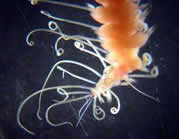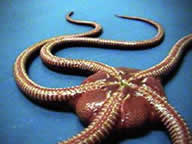Team finds strange, rarely seen creatures of the deep
BY LYNNE LANGLEY
Of The Post and Courier Staff
Lowcountry marine scientists battled a huge swordfish 1,800 feet under the sea at the Charleston Bump, deployed clod cards at the Velvet Steps, collected amazing rocks and videotaped strange creatures that many people never have seen until this week.

PHOTO PROVIDED BY NOAA
This polychaete worm was discovered under a microscope by Jerry McLelland
of the University of Southern Mississippi after it was collected on a
rock during a deep-sea dive. Related to earthworms, it has long white
appendages called dorsal cirri.
The federal Ocean Exploration expedition will end in Charleston today,
and leaders are describing the 11-day voyage as a success despite intense
storms, dangerous deep-sea currents, lost equipment and other perils.
From far out to sea over the rocky formation called the Charleston Bump, expedition chief scientist Charlie Barans said by e-mail, "One has to be prepared for submersible dives that are off target due to strong Gulf Stream currents and many fewer dives than hoped for due to the unusually nasty weather offshore."
The team had completed the 14th of 22 planned deep-sea dives as it headed home Wednesday night. "We're very pleased," Barans said. Among them were 2,000-foot-deep dives to caves and cliff holes, where the manipulator arm of the Johnson Sea-Link reached in and sucked out hiding critters.
"It's the right habitat to find new species and things not known well," said Charleston marine scientist George Sedberry, the expedition's principal investigator.
Barans added: "The interesting thing about a cruise is that, in many cases, you do not know what you have seen or collected that is unknown until you have checked out all other sources of information, which can take years. Many of the invertebrates (animals without spines) are exciting because the scientists of this cruise have not seen them before."
In their S.C. Department of Natural Resources labs, Sedberry and Barans will study the jars and plastic bags full of creatures captured in the darkness at the bottom of the Charleston Bump, an outcropping of clifflike walls, overhanging rocky edges, pavementlike ramps and precipitous drops that some scientists think formed 10 million to 15 million years ago.
The feature, about 83 miles southeast of Charleston, deflects the passing Gulf Stream and appears to serve as spawning and nursery grounds for swordfish and other popular marine fish.
DNR marine scientist Elizabeth Wenner met an 8-foot-long swordfish 1,800 feet down when it flashed past the submersible then repeatedly struck the thick titanium hull.
"The swordfish must have been protecting its territory or thought that the sub was a threat in some way. It thrashed against the sub and injured itself in the rigging. Blood was gushing from it," Wenner wrote from her computer at sea.
A swordfish once attacked another submersible, perhaps because the fish saw lights from instruments inside in the otherwise pitch-black depths, Sedberry said.
Wenner also watched two octopuses defend their rock as the submersible passed and several lionfish, exotic newcomers from halfway around the world that seem to be multiplying in the ocean near Charleston.
Beyond the fish that commercial and recreational fishermen seek on the surface, little was known about the Charleston Bump until the expedition visited the bottom. Scientists viewed for the first time the creatures, their activity, habitats and adaptation to survive the fast, scouring currents around the bump.
PHOTO PROVIDED BY NOAA 
Thought to be rare, many brittle stars were found on a single dive.
Basket stars and soft corals dominate exposed rock outcrops to grab food
passing in currents while sponges and sea squirts, which can generate
their own currents, choose sheltered spots under rocks, reported Steve
Stancyk, a University of South Carolina scientist who collected some of
those animals.
Susan DeVictor of DNR was fascinated by a football-sized tunicate, a close relative of the sea squirt, and by tiny life forms the size of sand grains.
College of Charleston geologist Dr. Leslie Sautter raved about the array of rocks and exciting organisms living on them. "One was an unknown blue thing that turned out to be an encrusting sponge."
And Burke High School teacher Connie Leverett reported after her dive, "I was amazed by the diversity of life among the rocks: The amount of sea snow (globs of dead matter) was similar to being in a snow globe looking out."
Sedberry learned more about the habitats of wreckfish, a commercial fish harvested above the bump, and was surprised to find so many alfonsin. The bright red fish is a popular food in Europe and Asia but not in this country, at least not yet.
The submersible placed and later retrieved specially made "clod cards," alabaster slabs that dissolve over time and show how strong currents run at the bump, as well as carrion buckets loaded with dead oysters, designed to attract and then capture unknown or barely known residents.
"Our expedition is unique, and each day our science team and crew members become the first to explore a small portion of our planet previously untouched by human interventions," Rich Styles of USC said.
Based on the area that Charleston Bump dives explored, Styles calculated it would take 1.8 million years to see every spot on the floor of all the world's oceans, even if 100 similar missions were carried out each year.
They won't be, of course, and so the expedition is making sophisticated sonar surveys on the surface, which will be correlated with what scientists saw and videotaped on the ocean floor.
They examined rock formations and
other bottom geology, current patterns and which animals live in different
conditions. Future sonar surveys of unexplored areas could indicate what
might live there and help biologists manage species that are important
commercially and recreationally, said Sedberry.